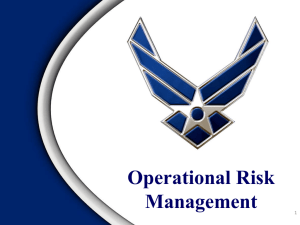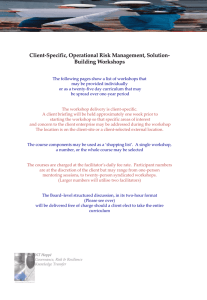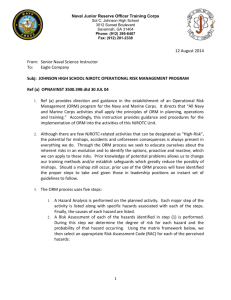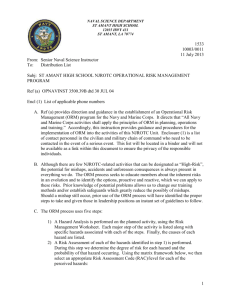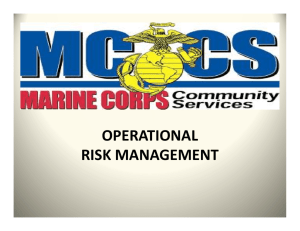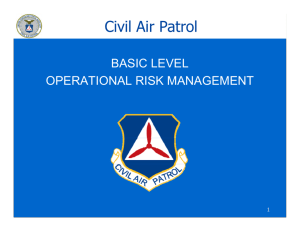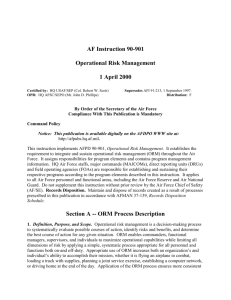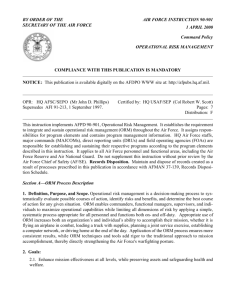RISKS? - Madden Maritime
advertisement
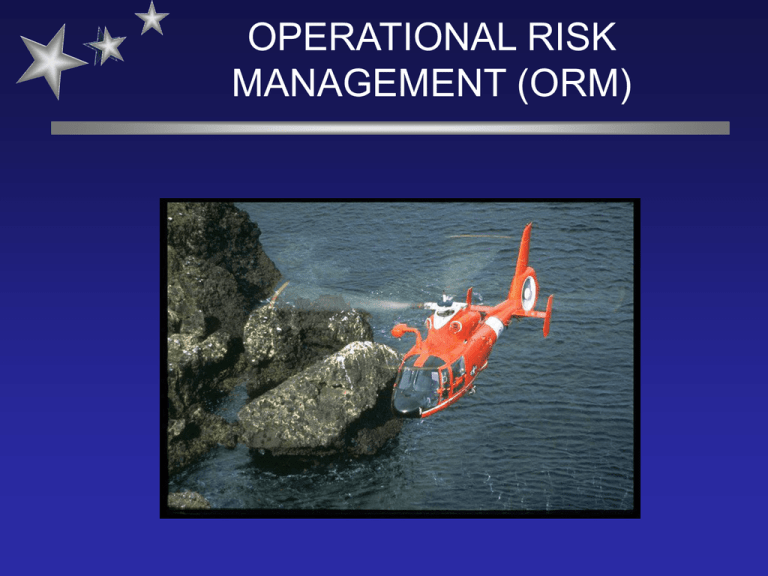
OPERATIONAL RISK MANAGEMENT (ORM) OBJECTIVES Describe what ORM is and why the USCG is using it. Describe when and why to apply ORM. Use the seven step USCG ORM process. Use USCG ORM tools and job aids. WHAT IS OPERATIONAL RISK MANAGEMENT (ORM)? A systematic approach to optimizing risk to support best mission outcomes. A specific seven step process supported with tools and job aids. USCG ORM VISION “Increase mission success while reducing the risk to personnel, resources and the environment…” “Change from a compliance based to a riskbased philosophy…” “Provide logical process to identify & exploit opportunities producing greatest return on our investment…” WHY IMPLEMENT ORM? ORM applications are proven to offer mission supportive breakthrough potential. Force reductions make every USCG person and item of equipment more critical to mission success. ORM can significantly increase USCG operational capabilities and training realism. 4 KEY ORM PRINCIPLES 1. Accept no unnecessary risks. 2. Make risk decisions at the appropriate level. 3. Accept risks when benefits outweigh costs. 4. Integrate ORM into operations and planning at all levels. 1. Accept No Unnecessary Risks BUT.... NOBODY TAKES “UNNECESSARY” RISKS? If all the hazards that could have been detected have not been detected then unnecessary risks are being accepted. The single greatest advantage of ORM over traditional risk management is the consistent detection of 50%+ more hazards. 2. Make Risk Decisions at the Appropriate Level Factors below become basis of a decision-making system to guide leaders Who has operational control & responsibility? Who is the senior person at the scene? Who possesses best insight into the full benefits and costs of a risk? Who has the resources to mitigate the risk? What level makes the most operational sense? 3. Accept Risks When Benefits Outweigh Costs. MAINTAINING A BOLD, RISK-TAKING ORGANIZATION IS ALWAYS A CHALLENGE. ORM HELPS. Taking calculated risks is essential for an organization to grow and capitalize on its capabilities. 4. Integrate ORM Into Operations and Planning At All Levels. Loss Control Staff Injects Operational Process Operational Leaders Add-On Operational Process This is the one we want!! Operational Process Loss Control Occurs Within The Process HOW WILL THE COAST GUARD IMPLEMENT ORM? Apply the seven step ORM process and the supporting tools In a consistently mission supportive way Through a highly integrated and decentralized approach HOW DO WE ASSURE THAT ORM IS ALWAYS MISSION SUPPORTIVE? Target optimum mission risk, not minimum risk. Involve operators to insure risk controls are mission supportive. Use only the amount of ORM dictated by the risk. Low risk - less ORM, high risk - more ORM. USING THE 7-STEP PROCESS THE RISK MANAGEMENT CONTINUUM PLANNING -Deliberate ORM -Detailed Hazard ID -Integrated OPERATIONS AFTER-ACTION -Largely Time-Critical -Change Analysis -Real Time -Highly Decentralized -Assess Indicators -Deliberate ORM -Integration -Feedback We try to get most ORM done here But continue the process here and here WHAT IS THE SEVEN STEP ORM PROCESS? Identify Mission Tasks A decision-making technique Identify Hazards A job aid & tool Assess Risks Identify Options Optimizes risk Evaluate Risk vs Gain Execute Decision Monitor Situation Step 1 - Identify Mission Task (COMDTINST 3500.3, Encl 1) Clearly state the mission objective. Define what tasks are required to accomplish the mission. Define the conditions under which to accomplish the task. Identify Mission Tasks Identify Hazards Assess Risks Identify Options Evaluate Risk vs Gain Execute Decision Monitor Situation THE MISSION ANALYSIS UNDERSTANDING THE FLOW OF EVENTS MISSION ANALYSIS METHOD: List the events in sequence. RESOURCES: Mission planners & operators. COMMENTS: ORM must cover all aspects of an operation. The Mission Analysis supports that. The “MA” is a must do! MISSION ANALYSIS Advance Rescue Ops Beach party on scene. Launch aircraft. Enroute considerations. Approach to water. “Survivor” & RS events. Aircraft Switch-Out Subsequent Scenarios Recovery all elements Step 2 - Identify the Hazards (COMDTINST 3500.3, page 4) Hazard: Any real or potential condition that can cause mission degradation, injury, illness, or death to personnel or damage to or loss of equipment or property. Identify Mission Tasks Identify Hazards Assess Risks Identify Options Evaluate Risk vs Gain Execute Decision Monitor Situation HAZARD ANALYSIS What can go wrong? Focus on the critical components of your mission: •Equipment •Personnel/Experience •Environment •Timeline OVERALL MISSION HAZARD ANALYSIS P.E.A.C.E. Planning Event What Can Go Wrong? • Equipment • Personnel • Environment • Timeline Asset Communication Environment What Safe Guards Exist? How Effective Are They? Step 3 - Assess the Risks Identify Mission Tasks The Process which associates “hazards with “risks”. Identify Hazards Assess Risks Identify Options Evaluate Risk vs Gain Execute Decision Monitor Situation HAZARD VERSUS RISK HAZARD RISK A description of a condition that can impair mission accomplishment. No indication of its mission significance. A hazard for which we have estimated the severity, probability, and exposure to determine the scope with which it can impact our mission. ASSESS RISKS SEVERITY - What are the effects? PROBABILITY - Can this happen to us? EXPOSURE - What is the event frequency or degree of involvement? SEVERITY Potential Consequences measured in terms of degree of impact on: Mission Man Machine/Materiel SEVERITY CATEGORIES CATASTROPHIC - Complete mission failure, death, or loss of system. MAJOR - Major mission degradation, severe injury, occupational illness, or major system damage. SIGNIFICANT - Minor mission degradation, injury, minor occupational illness, or minor system damage. MINIMAL - Less than minor mission degradation, injury, occupational illness or minor system damage. NONE - No impact to personnel or mission outcome. PROBABILITY Likelihood that potential consequences will occur: Very likely to happen Likely, greater than 50% chance Occasional, about 50-50 chance Unlikely under normal conditions Remote under any conditions Acknowledge “uncertainty” EXPOSURE Duration/repetition/number of people &/or equipment involved in event: Great Above Average Average None or below average THE RISK PRIORITY LIST Biggest hazard Least hazard worthy of action By ranking the hazards, we can work them on a worst first basis. This is vital because risk control resources are always limited and should be directed at the big problems first to assure maximum bang for the buck. USCG Aviation Risk Assessment Model Simplifies SPE assessment through use of Green Amber Red (GAR) Model Date: _______ Mission: ___________________________ C. Airframe/Resources Risk Assessment Review questions and circle the score according to currently available information. Score items according to the examples given and instincts. Absence of data automatically sets the score to maximum point value. Planning: Thoroughness of pre-mission planning. Factors which increase risk, B-0 response assets, in-flight divert of asset. Adequate 1 h Minimal 2 3 1 Partially Mission Capable 2 5 Adequate 1 h2 Environment: Clear Guidance Benign 2 4 Selection of appropriate resources. Factors that effect risk: time at unit, unfamiliar w/OP area, fatigue, flight time (total time & time in type), crew rest, 5181’s, requestor’s knowledge of asset capabilities. 2 1 Adequate 2 3 h Marginal 4 6 Marginal 4 5 1 Hazardous 8 10 Adequate 3 Marginal 4 5 Risk vs. Gain Low Gain – Situation with intangible benefits or a low probability for providing concrete results. Examples include passenger transport, non-critical logistics missions, PAO demonstration flight, etc. Medium Gain – Situation that provides immediate, tangible benefits. Examples include saving property, protecting the environment, deterring illegal operations. High Gain– Situation that provides immediate, tangible benefits that if ignored could result in loss of life. Examples include Urgent SAR and MEDEVACs. Given the mission description above, what is the “Gain” for this mission? Vs. Risk Management Risk Management is the decision to control or reduce hazards. Below are Control Options to assist in risk control or reduction. Review the options and reassess the risks as appropriate. air/surface assets. 2 Re-assess Step 1 Values 5 Spread-out – Disperse the risk by launching additional B. Aircrew Excellent h Additional PRECOM/EXCOM, bring in fresh or more experienced crew. None 4 Add the values for each Risk Assessment and plot the final Risk Assessment on graph below (include re-assessment from Step 2). A. Pilots h 3 5 Asset: Excellent Marginal External condition surrounding mission: Weather, night, illumination, mountainous sea state, terrain, cutter based, alternate airfields, water temp, on-scene cover. Complex/ Innovation Required 3 5 assumption of risk. In these cases a decision to accept risk may be made with the stipulation that risk is reevaluated as the mission progress. (No adjustment to Risk Assessment) Reduce – Reduce or limit risk exposure: Refers to mission complexity and guidance or doctrine available. Factors which may increase risk: sketchy details or non-standard mission profile. 1 4 Ability to maintain comms throughout mission. Factors: internal w/command and external w/customer. Event: h 3 Communications: None 4 Fully Mission Capable h Accept – In some cases the benefit might justify the Risk Assessment (Hi/Med/Lo) Gain (Hi/Med/Lo) Use the Risk vs. Gain Chart on the next page for a recommendation on how to proceed with the mission. Transfer – If practical, locate a better suited asset to conduct the mission i.e. different airframe, surface asset, or crew. Avoid – Circumvent hazard: Wait for risk to subside i.e. wait until daylight or weather passes. 8 Low 6 24 Medium 32 40 High Step 4. Identify Options Are risks acceptable or unacceptable? Identify Mission Tasks Identify Hazards Can we modify the mission to reduce risk? Assess Risks Identify Options Evaluate Risk vs Gain Are any safeguards missing? Execute Decision Monitor Situation What new options should we consider? Use Risk Priority List - Attack “Worst First” IDENTIFY OPTIONS S.T.A.A.R Spread Out Transfer Avoid Accept Reduce Mission Priority & Time Criticality Often Drive Options Step 5. Evaluate Risk vs Gain Seek optimal risk management Gain should balance or outweigh the Risk Risk Decision made at lowest appropriate level Command validates Assessment & Management Equates to “Reality Check” Date: _______ Mission: ___________________________ C. Airframe/Resources Risk Assessment Review questions and circle the score according to currently available information. Score items according to the examples given and instincts. Absence of data automatically sets the score to maximum point value. Planning: Thoroughness of pre-mission planning. Factors which increase risk, B-0 response assets, in-flight divert of asset. Adequate 1 h Minimal 2 3 1 Partially Mission Capable 2 5 Adequate 1 h2 Environment: Clear Guidance Benign 2 4 Selection of appropriate resources. Factors that effect risk: time at unit, unfamiliar w/OP area, fatigue, flight time (total time & time in type), crew rest, 5181’s, requestor’s knowledge of asset capabilities. 2 1 Adequate 2 3 h Marginal 4 6 Marginal 4 5 1 Hazardous 8 10 Adequate 3 Marginal 4 5 Risk vs. Gain Low Gain – Situation with intangible benefits or a low probability for providing concrete results. Examples include passenger transport, non-critical logistics missions, PAO demonstration flight, etc. Medium Gain – Situation that provides immediate, tangible benefits. Examples include saving property, protecting the environment, deterring illegal operations. High Gain– Situation that provides immediate, tangible benefits that if ignored could result in loss of life. Examples include Urgent SAR and MEDEVACs. Given the mission description above, what is the “Gain” for this mission? Vs. Risk Management Risk Management is the decision to control or reduce hazards. Below are Control Options to assist in risk control or reduction. Review the options and reassess the risks as appropriate. air/surface assets. 2 Re-assess Step 1 Values 5 Spread-out – Disperse the risk by launching additional B. Aircrew Excellent h Additional PRECOM/EXCOM, bring in fresh or more experienced crew. None 4 Add the values for each Risk Assessment and plot the final Risk Assessment on graph below (include re-assessment from Step 2). A. Pilots h 3 5 Asset: Excellent Marginal External condition surrounding mission: Weather, night, illumination, mountainous sea state, terrain, cutter based, alternate airfields, water temp, on-scene cover. Complex/ Innovation Required 3 5 assumption of risk. In these cases a decision to accept risk may be made with the stipulation that risk is reevaluated as the mission progress. (No adjustment to Risk Assessment) Reduce – Reduce or limit risk exposure: Refers to mission complexity and guidance or doctrine available. Factors which may increase risk: sketchy details or non-standard mission profile. 1 4 Ability to maintain comms throughout mission. Factors: internal w/command and external w/customer. Event: h 3 Communications: None 4 Fully Mission Capable h Accept – In some cases the benefit might justify the Risk Assessment (Hi/Med/Lo) Gain (Hi/Med/Lo) Use the Risk vs. Gain Chart on the next page for a recommendation on how to proceed with the mission. Transfer – If practical, locate a better suited asset to conduct the mission i.e. different airframe, surface asset, or crew. Avoid – Circumvent hazard: Wait for risk to subside i.e. wait until daylight or weather passes. 8 Low 6 24 Medium 32 40 High Risk vs Gain Low Risk Medium Risk High Risk High Gain Medium Gain Low Gain Accept the Mission. Continue to monitor Risk Factors, if conditions or mission changes. Accept the Mission. Continue to monitor Risk Factors and employ Control Options when available. Accept the Mission only with Command endorsement. Communicate Risk vs. Gain to Chain of Command. Actively pursue Control Options to reduce Risk. Accept the Mission. Continue to monitor Risk Factors, if conditions or mission changes. Accept the Mission. Continue to monitor Risk Factors and employ Control Options when available. Accept the Mission only with Command endorsement. Communicate Risk vs. Gain to Chain of Command. Actively pursue Control Options to reduce Risk. Accept the Mission. Reevaluate Risk vs. Gain, should Risk Factors change. Accept the Mission. Continue to monitor Risk Factors and actively pursue Control Options to reduce Risk. Do not Accept the Mission. Communicate to Chain of Command. Wait until Risk Factors change or Control Options warrant. Step 6. Execute Decision Control Options must be implemented Identify Mission Tasks Identify Hazards Assess Risks Decision Rational must be communicated Identify Options Evaluate Risk vs Gain Execute Decision Facilitates S.A. regarding Risk Management process Monitor Situation Step 7. Monitor Situation Insure Control Options are effective Identify Mission Tasks Identify Hazards Assess Risks ID changes requiring further RA/RM Identify Options Evaluate Risk vs Gain Execute Decision Capture “Lessons Learned” Monitor Situation Failure to respond to changes can become Links in the Mishap Chain Questions? USING THE 7-STEP PROCESS LEVELS OF EFFORT “TIME CRITICAL” “DELIBERATE” “STRATEGIC” Little: - Time - Complexity - Risk Lot of: - Time - Complexity - Risk ORM is applied proportionate to operational complexity, criticality, and risk!
